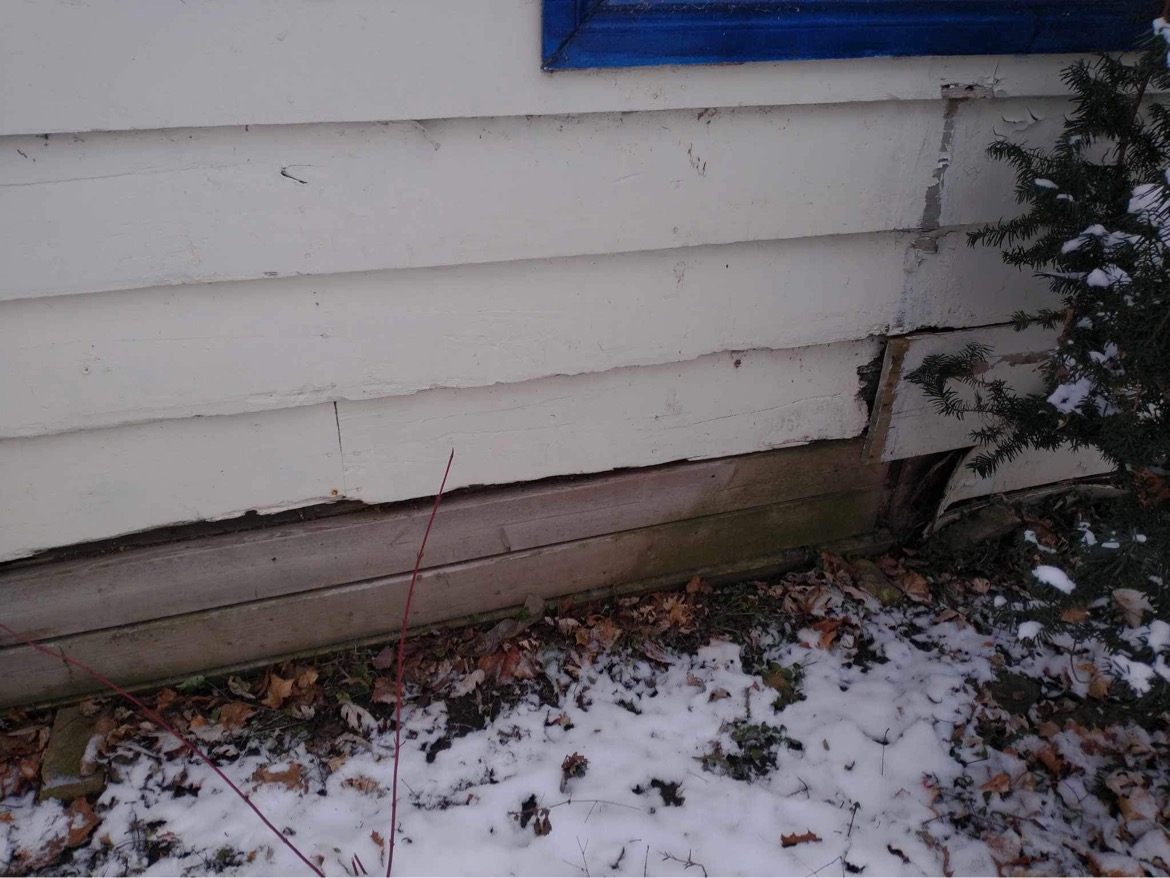By Heaven Silver
It was an early September morning in 2023 when Ted Lutman got news of his eviction notice. He’d recently returned from spending his summer working full-time as a camp counsellor, saving enough money to scrape by for his fourth year as an animation student at OCAD University. After walking his dog through his quiet neighbourhood in Oak Ridges, Richmond Hill, he headed home, a quaint, run-down cabin nestled between two towering lakefront mansions. Standing under the low-hanging stoop at his doorway was Ted’s landlord and he felt anxious.
As Ted invited his landlord in through the front door nearly falling off its hinges, they were immediately met with the pungent smell of black mould. Inside, floorboards creaked under their combined weight. His landlord noticed a gap about two inches wide dividing the kitchen and living room floor where the hard concrete foundation was visible underneath. Ted had been meaning to tell his landlord about tiles falling off in the shower but was interrupted.
“The house is falling apart and you’ll have to be out before March. I’m bulldozing this place,” his landlord said impassively. Ted felt his heart drop.
Ted always dreamed of moving to Toronto for school, as do many other low-income students. But when met with the harsh realities of the cost of living in the Greater Toronto Area, these students are forced into precarious and often extreme situations to contend with expenses. In Canada, youth from poorer households are less likely to attend post-secondary institutions as low-income students only account for 11.1 per cent of national undergraduate enrollment according to the University of Calgary Journal. Already facing economic barriers, these disparities are exacerbated by inflation as the average cost of living for students in the GTA skyrocketed from approximately $2400 per month including rent and tuition in 2018 to $3600 in 2023. Although many students can get financial assistance to cover tuition costs, they still must pay for rent, groceries and other necessities, putting them in a position where they are spread thin. But as costs continue to rise and the housing crisis shows no signs of abating, disadvantaged students are increasingly being cornered into a cycle of financial instability, making it exceedingly challenging to pursue higher education.
For many students balancing the competing demands of life at home and school, work compounds the difficulty. Living at home was the only option for Ted when he started university, but even without the additional cost of student residence, finances were tight. Ted’s dad was bedridden due to disability, and Ted was obligated to work part-time after class but could only take on 20 hours a week balancing his full-time studies. His lack of flexibility in his day-to-day schedule limited him to home, school, work and back, which he said felt isolating.
Coleen Clark, a personal finance expert at Toronto Metropolitan University, points out that a harsh reality for low-income working students is they are often forced to sacrifice school for work or vice versa. Students who attend school part-time to prioritize working a full-time job are likely deterred from pursuing more demanding degrees such as nursing or engineering, whereas students enrolled full-time risk smaller paychecks working fewer hours to compensate for a more intensive course load.
“It was a financial inequality thing,” Ted said. “In school, I felt there was a barrier between myself and my peers. As a cause of that, I didn’t really feel like there was anyone who shared my experience.”
It isn’t only practical realities that are impacted by finances, though. Having a social life is an important part of education that low-income students often miss out on since going out is no longer cheap, said Clark. In the past, additional trade-offs for students facing financial difficulties included taking out a loan or having roommates, but today’s disadvantaged students face different circumstances.
Gaps in equal access to higher education gone unaddressed by institutions have placed a heavy burden of fiscal responsibility onto students. Bottom line, the affordability issue is systemic rather than individual, but at the very least students can mitigate financial pressure by exercising prudence. Clark recommended all students keep track of monthly expenses, set a budget and learn mandatory versus discretionary spending.
In Ted’s case, however, managing money wasn’t an issue. Between OSAP, his dad’s disability payments and his meagre pay from his minimum-wage job, Ted got by as the sole provider paying bills, rent and groceries on top of tuition and other school-related expenses. To save money, Ted chose to bike to class four times a week. His trip from his house to OCAD’s campus in downtown Toronto took him about two hours one way.
Ted felt grateful that his grants from OSAP covered his cost of education, but many eligible disadvantaged students face financial shortfalls as aid calculations often don’t fully meet their needs.
According to StatsCan, around two-thirds of Ontario undergraduate students receive OSAP; however, tuition fees are outpacing government assistance. Since 2010, domestic tuition has surged by 29 per cent while provincial funding has decreased by nine per cent. Although student assistance programs such as OSAP are intended to supplement, not cover education costs, inflated tuition fees have compounded students’ struggle to contend with the rising cost of living, especially in the rental housing market, said Cara Stern, a journalist for the Smart Prosperity Institute and co-host of the Missing Middle podcast discussing affordable housing.
When Ted’s dad died in January 2023, he felt pressured to search for other living options as he struggled to make rent without his dad’s supplemental disability benefit. Initially, his grandma and uncle helped Ted look for a residence they could share with their combined monthly income of $3000. Working with a realtor, they made bids on numerous rentals in town but were always passed over.
Most students are renters, yet large-scale purpose-built rentals haven’t been developed in the GTA for decades, resulting in less stable and unaffordable housing options, said Stern. Many turn to newly constructed condos, facing annual rent hikes or eviction threats. Limited rental vacancies also push low-income students into overcrowded and unsafe living arrangements.
Lawrence Chen, a politics and governance student at TMU, depends on financial aid and works two jobs to cover his $700 monthly rent for the living room space he shares with two other students. As a refugee from Hong Kong, he’s grateful for OSAP but frequently relies on the campus food bank for groceries.
As of 2023, over half of post-secondary students in Canada were food insecure. Xielle Zhang, Operations Lead at the Good Food Centre, TMU’s campus food bank, said that since the start of the pandemic, there has been a 500 per cent increase in usage at the GFC. Zhang expressed uncertainty about the GFC’s ability to consistently meet supply and demand despite helping students balance expenses like food, rent and commuting.
In today’s market, compared to most other students in similar circumstances, Ted has been fortunate. In January 2024, he settled into an affordable and spacious co-op house in the Annex shared with ten other roommates. His financial burden has significantly lightened, but he remains concerned that his savings and paycheck may not be sufficient to sustain him in the coming months.
Stern urged students and young people to mobilize and demand accountability from politicians as existing solutions are being overlooked.
“It’s not fair that you need to be somewhat independently wealthy or have a lot of family support in order to go to university,” said Stern. “That system needs to change.”





